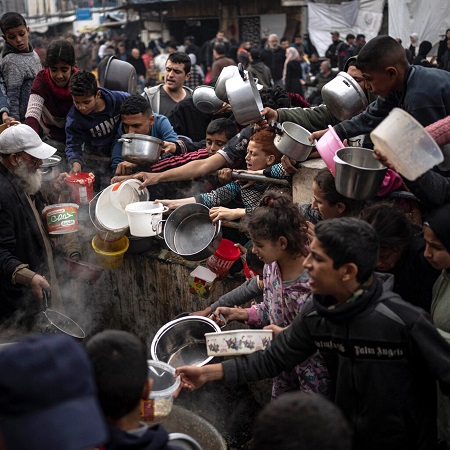Famine has become a central humanitarian concern in the enclave.
Mothers in Gaza are struggling to find clean water and baby formula for their newborns. Families are selling their possessions to buy sacks of flour. Some people are eating animal feed to survive.
In the northern city of Beit Lahia, Mahmoud Shalabi said people have brought cattle feed — made of corn or oat — to a mill to grind it into flour. It is barely edible, said Shalabi, 38, whose children are 7 and 9, but is preferable to starvation. “If you find it now,” he told us, “you will be able to have something to eat and feed your kids.”
Famine has become a central concern in the humanitarian calamity in Gaza, with nearly all households regularly skipping meals, according to the U.N. On a per capita basis, Bob Kitchen of the International Rescue Committee said, “It is the most intense hunger crisis I have ever seen.” He added: “Almost everyone is now hungry.”
In today’s newsletter, we will explain the crisis in Gaza — and the concern among experts that starvation has again become a tool of war.
The siege
Gaza’s food shortage stems mostly from Israel’s blockade, which has been especially intense since October.
Gaza is an arid strip of densely populated land where the economy depends on imports to produce enough food. For years, Israel has limited the flow of goods into Gaza, largely to prevent Hamas from gaining access to military supplies. The limits also restricted the entry of food and other basic items.
After the Hamas-led 7 October terrorist attacks, Israel ordered what its defense minister called a “complete siege” of Gaza. The goal was both to weaken Hamas fighters and to ensure that no military supplies could enter. Israeli officials claim that they are still allowing food and other humanitarian supplies into the enclave, but that aid groups have not distributed them efficiently. On Twitter, Israel’s government recently posted a photo of aid trucks sitting idle at Gaza’s border and wrote, “Stop spreading accusations and start doing your job.”
Israeli officials have also accused the agency in charge of humanitarian aid in Gaza — the United Nations Relief and Works Agency — of colluding with Hamas and being biased against Israel. (On Friday, the U.N. fired several employees of the agency and began investigating accusations that they had participated in the 7 October attacks. Read the latest details.)
Still, many human rights experts dispute that inefficient aid distribution is the main cause of the food shortage. Israel, these experts say, has been too slow to inspect supplies and approve them for entry. Only 20 percent to 30 percent of what people need has been crossing into Gaza, according to the World Food Program. “Israel says the reason is security,” Stephanie Nolen, who covers global health for The Times, told us. “But the net result is that you can’t actually get food in.”
In a ruling on Friday, the International Court of Justice — an arbiter of international law, based in the Netherlands — found that many people in Gaza have “no access to the most basic foodstuffs, potable water, electricity, essential medicines or heating.” The court ordered Israel to allow more supplies to enter Gaza immediately, although the court has little ability to enforce the ruling.
Hamas and Egypt also bear some responsibility for the hunger crisis. Western and Arab officials have said that Hamas has kept a large stockpile of food, fuel and medicine for the group’s own members to use.
Egypt, for its part, shares a border with southern Gaza yet has blocked most Gazans from fleeing the war zone. Egypt’s actions contrast with the refugee policies of other border nations during wars, including in Ukraine and South Sudan, where neighboring countries have prioritized civilian lives.
Gaza’s food situation is dire enough to have become part of the negotiations between Israel and Hamas over the release of Israeli hostages and a possible cease-fire. Officials from the U.S., Egypt and Qatar are participating in the talks, and some have grown hopeful that they are close to a deal.
(Related: Israel yesterday stepped up efforts to prevent Israeli protesters from blocking aid into Gaza. The protesters say no aid should enter until Hamas releases hostages.)
Feckless law
Our colleague Stephanie Nolen has noted that the world seemed to be moving away from starvation as a weapon of war in the late 20th century.
The tactic was common during World War II, when a Nazi strategy called “Hungerplan” helped kill millions of Soviets and the U.S. military conducted Operation Starvation to block the delivery of food to Japan. In 1998, however, a new statute of international law criminalized the use of civilian starvation as a military tactic.
Still, several countries have evidently used the tactic over the past seven years, including Saudi Arabia against Yemen; Syria’s own government against its people; and Ethiopia, to fight rebels in its Tigray region. These governments have suffered few consequences. Palestinians accuse Israel of repeating the pattern in Gaza.
For more:
The dire — and sometimes lasting — effects of starvation on the human body.
Photo: A scene from a food line in Rafah, in southern Gaza. Fatima Shbair/Associated Press.
| Themes |
| • Displaced • Displacement • ESC rights • Food (rights, sovereignty, crisis) • Indigenous peoples • Local • People under occupation • Population transfers • Public policies • Refugees • Regional |














